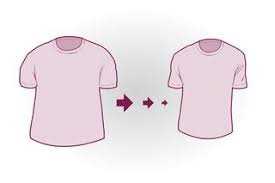


Have you ever found yourself with a new piece of clothing that is just a bit too big? Maybe you had your eye on a beautiful dress or a stylish pair of jeans, but they only had a size larger than what you normally wear. Instead of giving up on your dream outfit, why not try shrinking it to the perfect size?
Shrinking clothes can be a simple and effective way to alter the fit of a garment. Whether you want to shrink a t-shirt, a pair of pants, or even a sweater, this step-by-step guide will walk you through the process. With a few household items and some patience, you’ll be able to achieve the perfect fit for your clothes.
Before you start, it’s important to note that not all fabrics are suitable for shrinking. Natural materials, such as cotton or wool, are more likely to shrink successfully compared to synthetic fabrics. It’s also important to consider the care instructions on the tag of your garment – some fabrics may not be suitable for shrinking at all.
Once you’ve determined that your garment is suitable for shrinking, the first step is to prepare it for the process. This may involve washing the garment in hot water or soaking it in a mixture of hot water and vinegar. After the preparation, you’ll need to dry the garment in high heat – either in the dryer or by using an iron.
Remember, the key to successfully shrinking clothes is to go slow and steady. You don’t want to risk damaging the fabric by using too much heat or by drying it for too long. By following this step-by-step guide, you’ll be able to purposefully shrink your clothes and achieve the perfect fit you’ve always wanted.
Understanding the Fabric
Before attempting to shrink your clothes, it’s important to understand the fabric they are made of. Different fabrics react differently to heat and moisture, so knowing the fabric will help you determine the best method for shrinking.
Cotton: Cotton is a natural fabric that is known to shrink when exposed to heat. It has good moisture absorption properties, which makes it more susceptible to shrinking when it comes into contact with water.
Wool: Wool is a natural fiber that can shrink easily if not handled properly. It is sensitive to heat and moisture, so it’s important to follow specific instructions when attempting to shrink woolen clothes.
Synthetic Fabrics: Synthetic fabrics, such as polyester and nylon, are less likely to shrink compared to natural fibers. They have been engineered to withstand heat and moisture and maintain their shape and size even after multiple washes.
Blends: Many clothes are made from a blend of two or more different fabrics. In this case, it’s important to identify the fabric that makes up the majority of the blend to determine how the garment will react to heat and moisture.
Checking the Care Label: The care label on your clothes will provide information on the fabric composition and specific care instructions. Always check the care label before attempting to shrink your clothes to avoid damaging them.
Testing the Fabric
Before shrinking the entire garment, it’s a good idea to test the fabric by shrinking a small section or a swatch. This will help you determine how the fabric reacts to the shrinking process and if any damage occurs.
Here’s how you can test the fabric:
- Take a small section of the fabric or a swatch.
- Pre-wash the fabric according to the care instructions.
- Place the fabric in hot water for a few minutes.
- Remove the fabric from the water and let it air dry.
- Observe if the fabric has shrunk or if any damage has occurred.
If the fabric shrinks without any damage, you can proceed to shrink the entire garment using the appropriate method. If the fabric doesn’t shrink or gets damaged, it’s best to avoid attempting to shrink the garment.
Preparing the Clothes for Shrinkage

Before you can purposefully shrink your clothes, it’s important to prepare them properly. This will help ensure that the shrinking process is effective and that the clothes will fit you properly after they have been shrunk. Follow these steps to prepare your clothes for shrinkage:
- Read the care labels: Start by checking the care labels on your clothes. Not all fabrics are suitable for shrinking, so it’s important to make sure that the clothes can be safely subjected to the shrinking process. If the care labels mention that the fabric is not pre-shrunk or can be washed in hot water, it’s a good indication that the fabric is suitable for shrinking.
- Sort your clothes: Sort your clothes based on the fabric type. It’s best to shrink clothes made from natural fibers such as cotton, linen, or wool. These fabrics tend to shrink more easily compared to synthetic materials. Separate your clothes into different piles based on their fabric type.
- Pre-wash the clothes: Before shrinking your clothes, it’s recommended to pre-wash them. This will help remove any dirt, stains, or chemicals that may interfere with the shrinking process. Use the recommended water temperature mentioned on the care labels and detergent appropriate for the fabric. Make sure to dry the clothes properly after pre-washing.
- Check for stains or damages: Inspect your clothes for any stains or damages that need to be treated before shrinking. Stains can become set in the fabric during the shrinking process, so it’s best to address them beforehand. If there are any damages like holes or loose threads, consider repairing them before shrinking to avoid further damage.
- Measure your clothes: Take measurements of your clothes before shrinking them. This will help you determine the extent of the shrinkage and ensure that the clothes will still fit you properly after they have been shrunk. Measure the length, width, and any other important dimensions that may affect the fit of the clothes.
- Prepare a suitable shrinking method: Depending on the fabric type and your preferences, choose a suitable shrinking method. Common methods include washing and drying clothes in hot water and high heat settings, using a hot iron, or using a steam machine. Make sure to research the specific method for your fabric type to achieve the best results.
By following these steps, you can properly prepare your clothes for shrinkage and increase the chances of achieving the desired fit after they have been shrunk.
Choosing the Right Shrinkage Method

When it comes to intentionally shrinking clothes, there are several methods you can choose from. Each method has its own advantages and disadvantages, so it’s important to consider your specific needs and preferences before deciding on a shrinkage method.
1. Hot Water and High Heat

One of the most common and effective ways to shrink clothes is by using hot water and high heat. This method is ideal for natural fibers like cotton and linen, as they have a tendency to shrink when exposed to heat. Here’s how you can use hot water and high heat to purposefully shrink your clothes:
- Fill a basin or sink with hot water.
- Add your clothes to the hot water and let them soak for about 30 minutes.
- After soaking, remove the clothes from the water and wring them out gently.
- Place the damp clothes in the clothes dryer and set it to the highest heat setting.
- Allow the clothes to dry completely in the dryer.
Note: It’s important to remember that this method may not work for all fabrics, so be sure to check the care label on your clothes before attempting to shrink them using hot water and high heat.
2. Boiling Water

If you have clothes made of synthetic fibers like polyester or nylon, you can try using boiling water to shrink them. Here’s how you can do it:
- Fill a pot with enough water to fully submerge your clothes.
- Bring the water to a rolling boil.
- Add your clothes to the boiling water and let them boil for about 10 minutes.
- After boiling, remove the clothes from the water and wring them out gently.
- Place the damp clothes in the clothes dryer and set it to the highest heat setting.
- Allow the clothes to dry completely in the dryer.
Keep in mind that this method should be used cautiously, as boiling water can cause damage to some fabrics. Always check the care label on your clothes and perform a small patch test before attempting to shrink them using boiling water.
3. Steam

If you’re looking for a gentler method to shrink your clothes, using steam can be a good option. This method works well for delicate fabrics that may be prone to damage from high heat. Here’s how you can use steam to shrink your clothes:
- Hang your clothes on a hanger.
- Set up a handheld garment steamer according to the manufacturer’s instructions.
- Hold the steamer about 6 inches away from the clothes and move it slowly and evenly across the fabric.
- Allow the clothes to air dry.
Using steam is generally safe for most fabrics, but it may not provide as significant shrinkage as other methods. If you need a more noticeable shrinkage, you may want to consider using hot water and high heat instead.
| Shrinkage Method | Best for Fabrics | Advantages | Disadvantages |
|---|---|---|---|
| Hot Water and High Heat | Natural fibers like cotton and linen | Effective, widely available | May not work for all fabrics |
| Boiling Water | Synthetic fibers like polyester and nylon | Can provide significant shrinkage | Can damage some fabrics |
| Steam | Delicate fabrics | Gentle, safe for most fabrics | May not provide significant shrinkage |
By considering the fabric of your clothes and your desired level of shrinkage, you can choose the right shrinkage method that best suits your needs. Remember to always follow the care instructions on your clothes and perform a small test before attempting to shrink them.
Executing the Shrinkage Process
Once you’ve prepared your clothing item and gathered all the necessary materials, you’re ready to begin the shrinkage process. Follow these steps for successful shrinking:
- Set up your workspace:
- Prepare the hot water:
- Add detergent or fabric softener:
- Submerge the clothing item:
- Monitor the process:
- Drain the water:
- Rinse with cold water:
- Remove excess water:
- Reshape and dry:
- Check the final result:
Choose a well-ventilated area with a flat surface, such as a table or counter, to work on. Make sure you have enough space to lay out the clothing item without it touching anything else.
Fill a large basin or sink with hot water. The water should be as hot as your clothing item can withstand without damage. Refer to the garment’s care label for specific temperature recommendations.
If desired, add a small amount of detergent or fabric softener to the hot water. This can help to relax the fibers and increase the chances of successful shrinkage. Be cautious not to use too much, as it may leave residue on your clothes.
Place the clothing item into the hot water, ensuring that it is fully submerged. Gently move it around to ensure the hot water reaches all areas of the fabric.
Keep a close eye on the clothing item while it is soaking in the hot water. Check its size and texture periodically to determine if it has shrunk sufficiently. The length of time needed for shrinkage will vary depending on the fabric type and desired reduction.
Once the clothing item has reached your desired size, carefully drain the hot water from the basin or sink. Be cautious not to burn yourself in the process.
Rinse the clothing item thoroughly with cold water to remove any excess detergent or fabric softener. Cold water helps to re-set the fibers and prevent further shrinking.
Gently squeeze out any excess water from the clothing item. Avoid wringing or twisting the fabric, as this can damage the fibers.
Reshape the clothing item to its original shape and size while it is still damp. Lay it flat on a clean, dry towel or hang it up to air dry. Avoid using a clothes dryer, as this can cause further shrinkage.
Once the clothing item is completely dry, try it on to check if it has shrunk to your desired size. If not, you may need to repeat the shrinkage process or consider alternative methods of shrinking.
Following these steps will help you successfully shrink your clothes to the desired size. Remember to always check the care label of your clothing items for any specific instructions or recommendations. Happy shrinking!
Proper Care and Maintenance of Shrunken Clothes
Once you have successfully shrunk your clothes to the desired size, it is important to properly care for and maintain them to ensure their longevity. Here are a few tips and guidelines to follow:
- Hand Wash: It is recommended to hand wash your shrunken clothes instead of using a washing machine. This will help prevent any further shrinkage and damage to the fabric.
- Use Cold Water: When washing your shrunken clothes, always use cold water. Hot water can cause additional shrinkage, so it is best to avoid it.
- Gentle Detergent: Choose a gentle detergent that is specifically designed for delicate fabrics. Avoid using harsh chemicals or bleaching agents, as they can weaken the fabric fibers and cause damage.
- Air Dry: After washing your shrunken clothes, avoid using a dryer. Instead, gently squeeze out any excess water and lay the garment flat to air dry. This will help maintain the shape and size of the clothes.
- Iron with Caution: If your shrunken clothes require ironing, use a low heat setting and iron them gently. Be careful not to apply too much pressure, as it can cause distortion or damage to the fabric.
By following these care and maintenance tips, you can ensure that your shrunken clothes remain in good condition and last longer. Remember, proper care and attention are essential for preserving the size and shape of your clothes after shrinking them.
FAQ
What materials can I use to shrink clothes?
You can use hot water, a washing machine, a dryer, or an iron to shrink clothes.
Can all types of fabric be shrunk?
No, not all types of fabric can be easily shrunk. Natural fibers like cotton and wool are more prone to shrinking, while synthetic fibers like polyester may be more difficult to shrink.
How hot should the water be when trying to shrink clothes?
The water should be as hot as possible without damaging the fabric. Generally, using hot water from the tap should be sufficient.
Can I shrink clothes that have already been washed and dried?
Yes, it is possible to shrink clothes that have already been washed and dried. You can try rewashing them in hot water and then drying them on high heat to further shrink them.
Is it possible to undo the shrinking process if I accidentally shrink a garment too much?
Unfortunately, once a garment has been shrunk, it is difficult to undo the shrinking process. It is best to be cautious and gradually shrink the garment to achieve the desired fit.
What is the purpose of purposefully shrinking clothes?
The purpose of purposefully shrinking clothes is to make them fit better or to achieve a certain desired look. Some people may have bought clothes that are slightly too large or want a more snug fit, while others may want to create a distressed or shrunken look for fashion purposes.
What are some methods for purposefully shrinking clothes?
There are several methods for purposefully shrinking clothes. One common method is to wash the clothes in hot water and then dry them on high heat. This can cause the fibers to contract and shrink the garment. Another method is to soak the clothes in a mixture of hot water and vinegar, which can also cause shrinkage. Some people also choose to use a hot iron to steam and shrink specific areas of the clothing.











